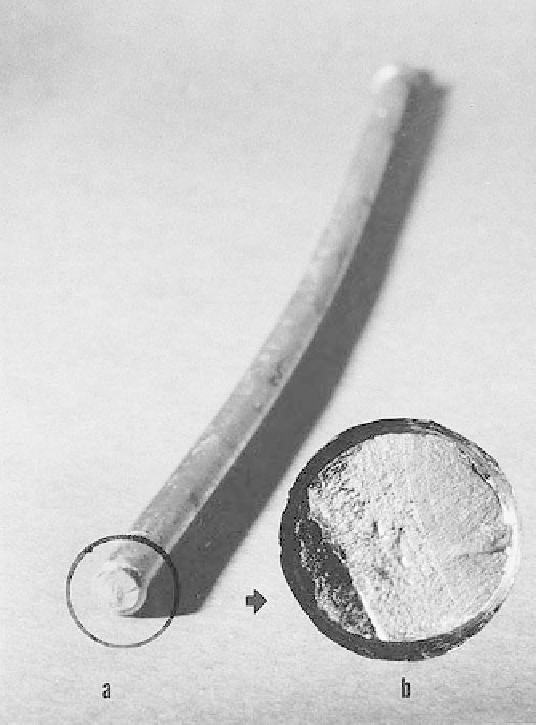Biomedical Engineering Reference
In-Depth Information
Fig. 3.2.9-14 The smooth part of a 316L stainless steel Harrington spinal distraction rod that fractured by fatigue in vivo. Note the bend
inthe rod (the rod was originally straight) and (insert) the relationship of the crack initiation zone of the fracture surface to the bend. The
inserted photo shows the nature of the fatigue fracture surface, which is characterized by a region of ''beach marks'' and a region of
sudden overload failure. (Photo courtesy of J. B. Brunski, D. C. Hill, and A. Moskowitz, 1983. Stresses in a Harrington distraction rod: their
origin and relationship to fatigue fractures in vivo. J. Biomech. Eng.105: 101-107.)
Bibliography
American Society for Testing and Materials
(1978). ASTM Standards for Medical
and Surgical Materials and Devices.
Authorized Reprint from
Annual Book
of ASTM Standards,
ASTM,
Philadelphia, PA.
Beevers, C. J., and Robinson, J. L. (1969).
Some observations on the influence of
oxygen content on the fatigue behavior
of
a
-titanium. J.
Less-Common Metals
17: 345-352.
Brunski, J. B., Hill, D. C., and Moskowitz,
A. (1983). Stresses in a Harrington
distraction rod: their origin and
relationship to fatigue fractures in vivo.
J.
Biomech. Eng.
105: 101-107.
Charles, J. A., and Crane, F. A. A. (1989).
Selection and Use of Engineering
Materials.
2nd ed. Butterworth-
Heinemann Ltd., Halley Court,
Oxford.
Compte, P. (1984). Metallurgical
observations of biomaterials. in
Contemporary Biomaterials,
J. W.
Boretos and M. Eden, eds. Noyes Publ.,
Park Ridge, NJ, pp. 66-91.
Conrad, H., Doner, M., and de Meester,
B. (1973). Critical review: deformation
and fracture. in
Titanium Science and
Technology,
Vol. 2, R. I. Jaffee and H. M.
Burte, eds. Plenum Press, New York,
pp. 969-1005.
Cox, D. O. (1977). The fatigue and
fracture behavior of a low stacking fault
energy cobalt-chromium-
molybdenum-carbon casting alloy used
for prosthetic devices. Ph.D.
dissertation, Engineering, University
of California at Los Angeles.
Davidson, J. A., and Georgette, F. S.
(1986). State-of-the-art materials for
orthopaedic prosthetic devices. in
Implant Manufacturing and Material
Technology.
Proc. Soc. of Manufacturing
Engineering, Itasca, IL.
Disegi, J. (1990). AO/ASIF Unalloyed
Titanium Implant Material. Technical
Brochure available from Synthes
(USA), P.O. Box 1766, 1690 Russell
Road, Paoli, PA, 19301-1222.
Golland, D. I., and Beevers, C. J. (1971).
Some effects of prior deformation and
annealing on the fatigue response of
a-titanium. J.
Less-Common Metals
23: 174.
Golland, D. I., and Beevers, C. J. (1971).
The effect of temperature on the
fatigue response of alpha-titanium.
Met.
Sci. J.
5: 174.
Gomez, M., Mancha, H., Salinas, A.,
Rodr´guez, J. L., Escobedo, J., Castro,
M., and M´ndez, M. (1997).






